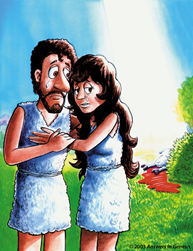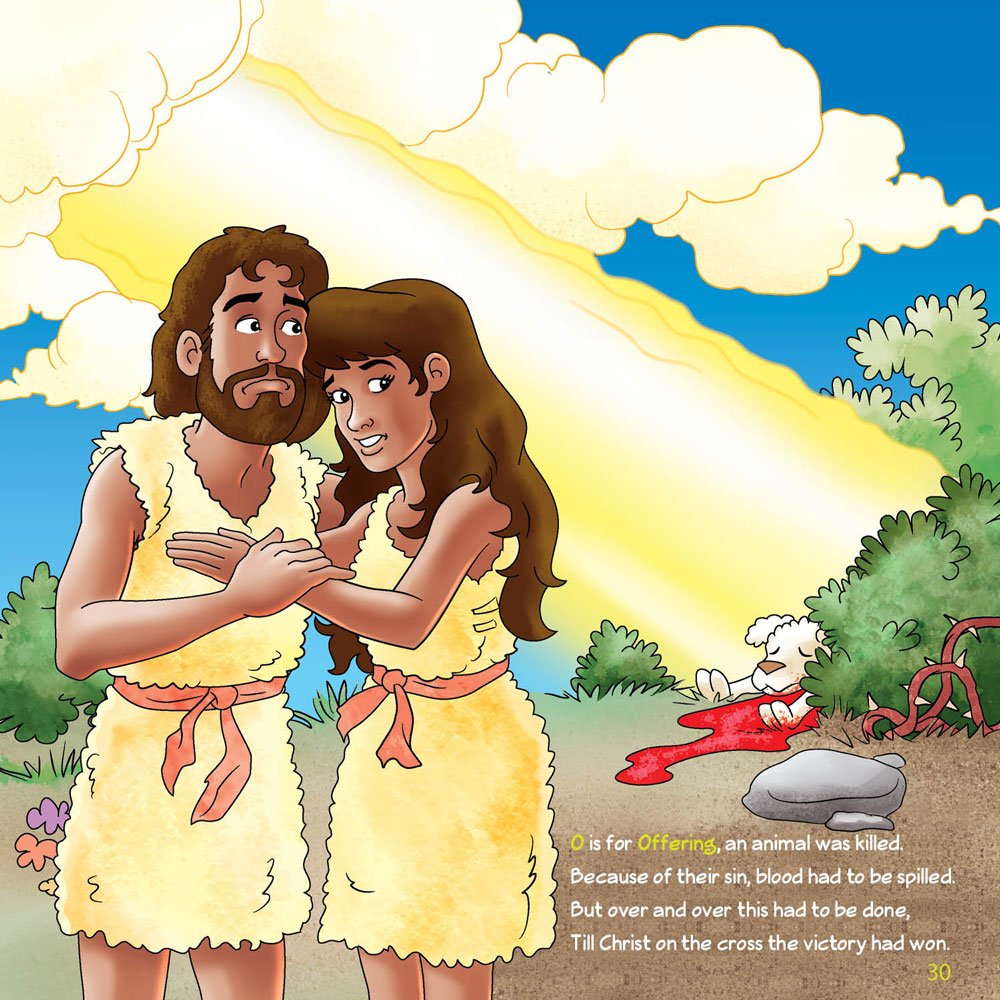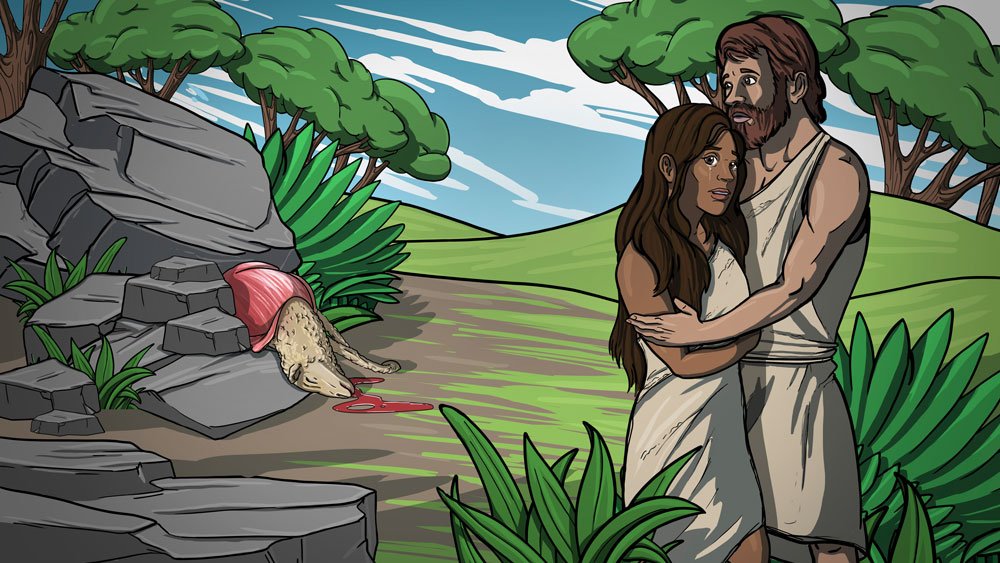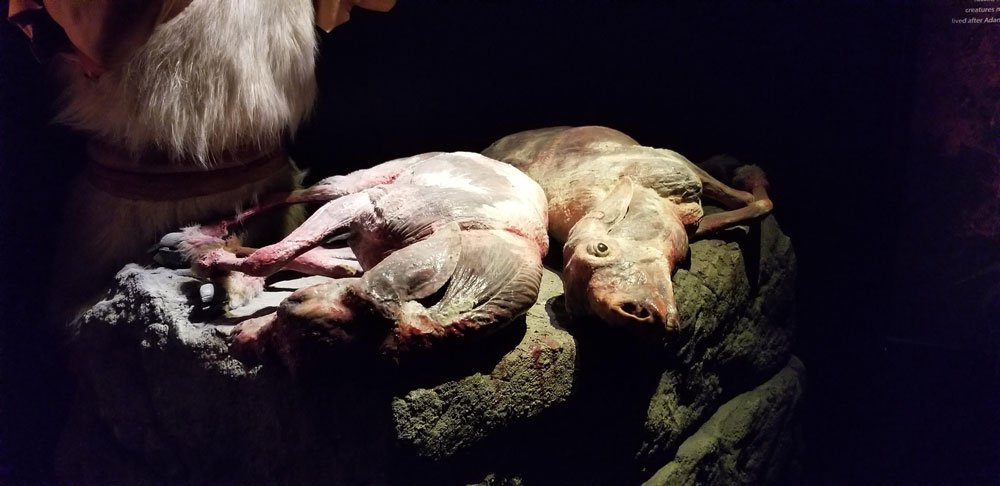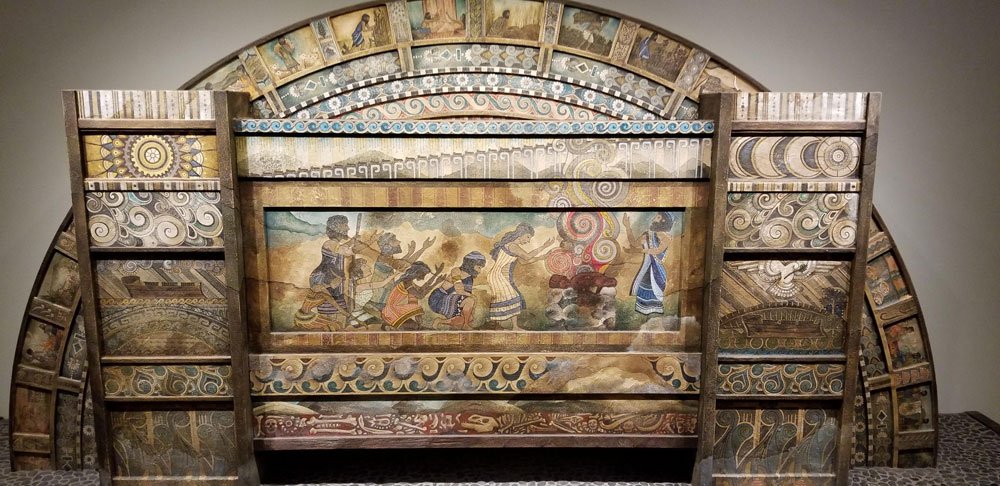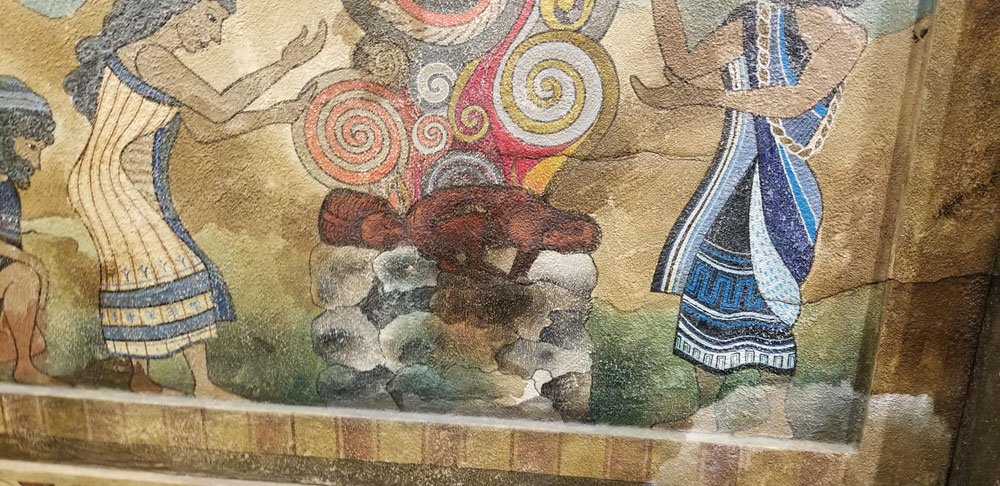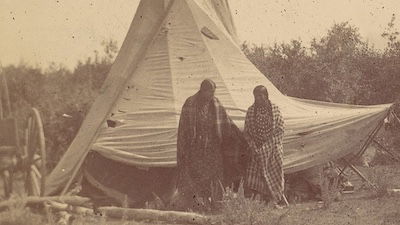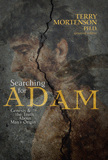
Dinosaurs On The Altar? Sacrificial Animals at the Ark Encounter
And the LORD God made for Adam and for his wife garments of skins and clothed them. (Genesis 3:21)
After Adam and Eve rebelled against God, they realized they were naked and covered themselves with fig leaves (Genesis 3:7). They tried to hide from the Lord among the trees in the garden. God confronted them and announced the consequences of their actions, which included the curse and death (Genesis 3:14–19), then the Bible tells us that the Lord made garments of skins for the first two people. He had told Adam that eating from the tree of the knowledge of good and evil would result in death (Genesis 2:17). But rather than taking Adam’s life immediately after his rebellion, which is what he deserved, the Lord demonstrated his mercy in sacrificing at least one animal in their place and making garments for Adam and Eve.
The offering of this kind of animal nicely foreshadows the ultimate sacrifice when the Son of God, “the Lamb of God who takes away the sins of the world”
Answers in Genesis has emphasized this passage for decades, calling attention to the fact that man’s sin required the penalty of death and that God is the one who carried out this first sacrifice. The Bible does not specify what kind of animal was sacrificed, but we have always chosen to depict it as a member of the goat/sheep kind. In Genesis 4:4, we read that Abel offered the firstborn of his flock to the Lord, so it is a reasonable assumption that he learned this from what his parents may have told him about that first sacrifice. Furthermore, the offering of this kind of animal nicely foreshadows the ultimate sacrifice when the Son of God, “the Lamb of God who takes away the sins of the world” (John 1:29), laid down His life for our sins.
Consider the following images used by Answers in Genesis over the years.
When the Ark Encounter opened in 2016, the Creation Museum sacrifice scene (above) was used as a reference for the artwork produced for the Pre-Flood World exhibit. The artwork in this exhibit is rather stylized, and as a result, some people have come away with the wrong impression of what animals are depicted on the altar. Here is the image that has led to some confusion.
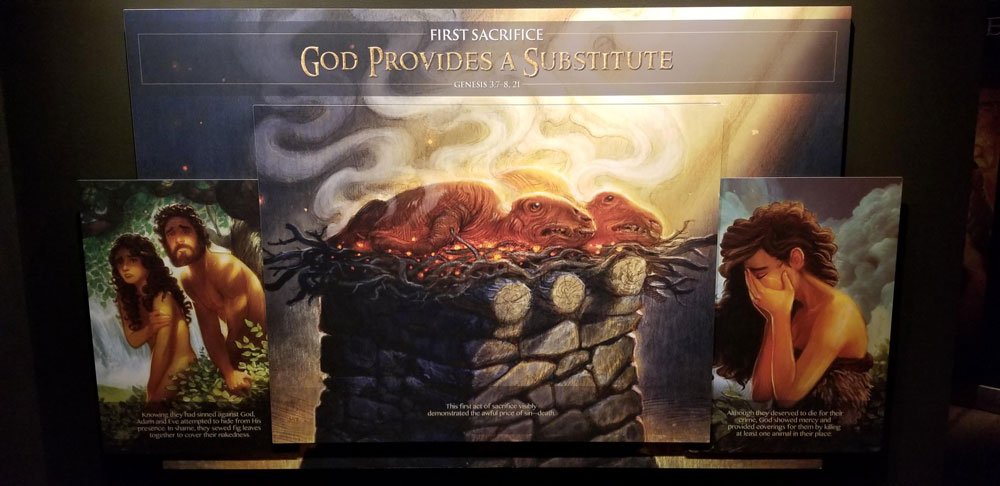
Artwork at the Ark Encounter since opening in 2016.
Some concerned guests have contacted us, asking why this image shows dinosaurs on the altar. Such an idea upsets them because dinosaurs would likely have been considered unclean animals in the Levitical regulations, making them unfit for sacrifice.
We cannot be sure if the clean/unclean distinction existed at this point in history, particularly since none of the animals were carnivores or scavengers until after Adam sinned.1 The first mention of the clean/unclean concept is found shortly before the flood in Genesis 7:2, but we are not told here what criteria were used at that time to distinguish between clean and unclean animals. Leviticus 11 includes the details God gave to Moses regarding clean and unclean animals, but this was many centuries after Noah. It is very possible the rules were the same, particularly since Moses wrote Genesis and Leviticus, so both he and his original audience would have likely understood the criteria to be the same. Since we had no other biblical guidelines to draw on, we used Leviticus 11 at the Ark Encounter to determine clean and unclean animals on the ark.2
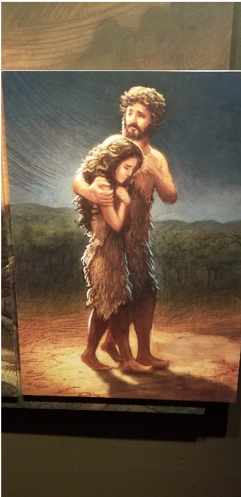
It is understandable that someone might get the impression that these are dinosaurs from a glance or without considering the context of the image. As mentioned above, the artwork is quite stylized. But other factors might lead to this misidentification. First, the two creatures have been skinned, so if guests were not anticipating this feature, it might lead them to think of these as something other than mammals. Second, the smoke from the fire creates a bit of distortion. Finally, the ears of these creatures are not visible. However, when compared to the reference image from the Creation Museum, it is clear that these are meant to be members of the goat/sheep kind.
Please notice the two images flanking the central picture. In the first, Adam and Eve are naked, and the text mentions that they sewed fig leaves together to cover their nakedness. But in the second, Eve is clothed with a woolen garment. The text here states, “Although they deserved to die for their crime, God showed mercy and provided coverings for them by killing at least one animal in their place.” Eve’s garment in this image could not have come from a dinosaur. Also, in the exhibit’s next sign, we see Adam and Eve wearing these same garments as God banished them from the garden.
Another stylized image at the Ark has also generated some confusion. The Rainbow Covenant exhibit on the Ark’s third deck features a beautiful rainbow-shaped monument depicting dozens of scenes and concepts from Genesis chapters 7–9. The most prominent image shows the sacrifice Noah offered to the Lord (Genesis 8:20).
Once again, the goat/sheep kind is featured on the altar, and the scene from the Creation Museum was used as a reference. However, a cursory glance at these creatures has given some people the impression that a dinosaur or monkey is on this altar, both of which would presumably have been unclean animals according to Levitical regulations.
Take a closer look at the image in question. Notice that there are two animals shown here. The first one (right) faces guests, while the second creature (left and a bit behind the other) is facing the middle of the altar. It is probably the shape of the first creature’s face that leads some people to think this is a monkey. However, the forelimbs of this animal are bent in the “ankle” in a manner consistent with hoofed quadrupeds like goats and sheep (often mistaken as a backward knee bend). These limbs certainly are not monkey arms.
Summary
Answers in Genesis has consistently chosen to depict the animals used in that first sacrifice as members of the goat/sheep kind. We realize the Bible doesn’t tell us which kind of animals were used, but we believe there are good reasons for showing it this way. Most notably, in showing it this way, it gives us an opportunity to point out the Lord’s sacrificial death on the Cross for our sins as the Lamb of God who takes away the sins of the world (John 1:29).
Footnotes
- The animals were originally created to eat plants (Genesis 1:30). Based on Leviticus 11:13–19, it seems as if a creature’s diet, particularly the predatory and scavenging birds, was a major factor in how they were categorized.
- If the knowledge of sacrifice from Abel’s time had been passed down to Noah, then he would have known of at least one kind of animal that was fit for sacrifice. However, he may not have needed to know prior to the flood how to discern between clean and unclean animals since they were not used for food, and there are no recorded restrictions for sacrifices. Since God sent the animals to Noah, the animals that only had two members show up would have been unclean, and those non-flying creatures that had seven pairs (or seven) show up would have been clean, suitable for sacrifice after the flood. There is some debate over the number of clean and unclean flying creatures aboard the ark based on the wording of Genesis 7:2–3. If there were seven pairs of every kind of flying creature (the view adopted at the Ark Encounter), then Noah would have needed to know how to discern between the clean and unclean. However, if only there were only two of each unclean flying creature and seven pairs of the clean, then once again, Noah would not have needed to know how to decide which were clean and unclean—the Lord would have done that for him by sending the correct number of each.
Recommended Resources

Answers in Genesis is an apologetics ministry, dedicated to helping Christians defend their faith and proclaim the good news of Jesus Christ.
- Customer Service 800.778.3390
- Available Monday–Friday | 9 AM–5 PM ET
- © 2025 Answers in Genesis

